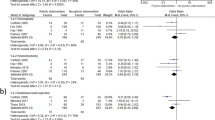Abstract
Introduction
Pyloric drainage during minimally invasive esophagectomy (MIE) may be more technically challenging than with an open approach. Alternatives to classic surgical drainage have increased in popularity; however, data are lacking to demonstrate whether one technique is superior in MIE. The purpose of this study was to compare post-operative outcomes after MIE between different pyloric drainage methods.
Methods
We performed a retrospective review of a prospectively maintained database of patients undergoing MIE at a single academic institution. Patients were divided into three groups for analysis: no drainage, intrapyloric Botulinum Toxin injection, and surgical drainage (pyloroplasty or pyloromyotomy). The primary outcome was any complication within 90 days of surgery; secondary outcomes included reported symptoms and need for pyloric dilation at 6 and 12 months post-operatively. Comparisons among groups were conducted using the Kruskal Wallis and Chi Square tests.
Results
There were 283 MIE performed between 2011 and 2017; of these, 126 (45%) had drainage (53 Botulinum injection and 73 surgical). No significant difference in the rate of post-operative complications, pneumonia, or anastomotic leak was observed between groups. At 6 and 12 months, patients that received Botulinum injection and surgical drainage had significantly more symptoms than no drainage (p < 0.0001) and higher need for pyloric dilation at 6 months (p = 0.007).
Conclusions
Pyloric drainage was not significantly associated with lower post-operative complications or long-term symptoms. While Botulinum injection appears safe post-operatively, it was associated with increased morbidity long-term. Pyloric drainage in MIE may be unnecessary.





Similar content being viewed by others
References
Lazzarino AI, Nagpal K, Bottle A, Faiz O, Moorthy K, Aylin P (2010) Open versus minimally invasive esophagectomy. Ann Surg 252:292–298
Wang H, Shen Y, Feng M, Zhang Y, Jiang W, Xu S, Tan L, Wang Q (2015) Outcomes, quality of life, and survival after esophagectomy for squamous cell carcinoma: a propensity score-matched comparison of operative approaches. J Thorac Cardiovasc Surg 149:1006–1015
Antonoff MB, Puri V, Meyers BF, Puri V, Meyers BF, Baumgartner K, Bell JM, Broderick S, Krupnick SA, Kreisel D, Patterson GA, Crabtree TD (2014) Comparison of pyloric intervention strategies at the time of esophagectomy: is more better? Ann Thorac Surg 97:1950–1957
Arya S, Markar SR, Karthikesalingam A, Hanna GB (2015) The impact of pyloric drainage on clinical outcome following esophagectomy: a systematic review. Dis Esophagus 28:326–335
Mannell A, McKnight A, Esser JD (1990) Role of pyloroplasty in the retrosternal stomach: results of a prospective, randomized, controlled trial. Br J Surg 77:57–59
Fok M, Cheng SW, Wong J (1991) Pyloroplasty versus no drainage in gastric replacement of the esophagus. Am J Surg 162:447–452
Chen K-N (2014) Managing complications I: leaks, strictures, emptying, reflux, chylothorax. J Thorac Dis 6(Suppl 3):S355–S363
Palmes D, Weilinghoff M, Colombo-Benkmann M, Senninger N, Bruewer M (2007) Effect of pyloric drainage procedures on gastric passage and bile reflux after esophagectomy with gastric conduit reconstruction. Langenbeck’s Arch Surg 392:135–141
Eldaif SM, Lee R, Adams KN, Kilgo PD, Gruszunski MA, Force SD, Pickens A, Fernandez FG, Luu TD, Miller DL (2014) Intrapyloric botulinum injection increases postoperative esophagectomy complications. Ann Thorac Surg 97:1959–1965
Kent MS, Pennathur A, Fabian T, McKelvey A, Shuchert MJ, Luketich JD, Landreneau RJ (2007) A pilot study of botulinum toxin injection for the treatment of delayed gastric emptying following esophagectomy. Surg Endosc 21:754–757
Cerfolio RJ, Bryant AS, Canon CL, Dhawan R, Eloubeidi MA (2009) Is botulinum toxin injection of the pylorus during Ivor Lewis esophagogastrectomy the optimal drainage strategy? J Thorac Cardiovasc Surg 137:565–572
Mungo B, Lido O, Stem M, Molena D (2016) Early experience and lessons learned in a new minimally invasive esophagectomy program. Surg Endosc 30:1692–1698
Dindo D, Demartines N, Clavien P-A (2004) Classification of surgical complications: a new proposal with evaluation in a cohort of 6336 patients and results of a survey. Ann Surg 240:205–213
Deldycke A, Van Daele E, Ceelen W, Van Nieuwenhove Y, Pattyn P (2016) Functional outcome after Ivor Lewis esopahgectomy for cancer. J Surg Oncol 113:24–28
Chattopadhyay TK, Gupta S, Padhy AK, Kapoor VK (1991) Is pyloroplasty necessary following intrathoracic transposition of stomach? Results of a prospective clinical study. Aust N Z J Surg 61:366–369
Mehran R, Rice D, EL-Zein R, Huang JL, Vaporciyan A, Goodyear A, Mehta A, Correa A, Walsh G, Roth J, Swisher S, Hofstetter W (2011) Minimally invasive esophagectomy versus open esophagectomy, a symptom assessment study. Dis Esophagus 24:147–152
Martin JT, Federico JA, McKelvey AA, Kent MS, Fabian T (2009) Prevention of delayed gastric emptying after esophagectomy: a single center’s experience with botulinum toxin. Ann Thorac Surg 87:1708–1713
Giugliano DN, Berger AC, Meidl H, Pucci MJ, Rosato EL, Keith SQ, Evans NR, Palazzo F (2017) Do intraoperative pyloric interventions predict the need for postoperative endoscopic interventions after minimally invasive esophagectomy? Dis Esophagus 30:1–8
Nguyen NT, Dholakia C, Nguyen X-MT, Reavis K (2010) Outcomes of minimally invasive esophagectomy without pyloroplasty: analysis of 109 cases. Am Surg 2010 76:1135–1138
Kukar M, Roswell Park Cancer Institute (2018) Botulinum toxin type A in preventing complications after surgery in patients with esophageal cancer. https://clinicaltrials.gov/ct2/show/NCT02965976. Accessed 10 July 2018
Funding
This study was supported, in part, by the National Institutes of Health /National Cancer Institute Cancer Support Grant P30 CA008748. Tamar Nobel is supported, in part, by a grant from the American Cancer Society.
Author information
Authors and Affiliations
Corresponding author
Ethics declarations
Disclosures
Tamar Nobel, Kay See Tan, Arianna Barbetta, Prasad Adusumilli, Manjit Bains, Matthew Bott, David Jones and Daniela Molena have no conflict of interest or financial ties to disclose.
Rights and permissions
About this article
Cite this article
Nobel, T., Tan, K.S., Barbetta, A. et al. Does pyloric drainage have a role in the era of minimally invasive esophagectomy?. Surg Endosc 33, 3218–3227 (2019). https://doi.org/10.1007/s00464-018-06607-8
Received:
Accepted:
Published:
Issue Date:
DOI: https://doi.org/10.1007/s00464-018-06607-8



